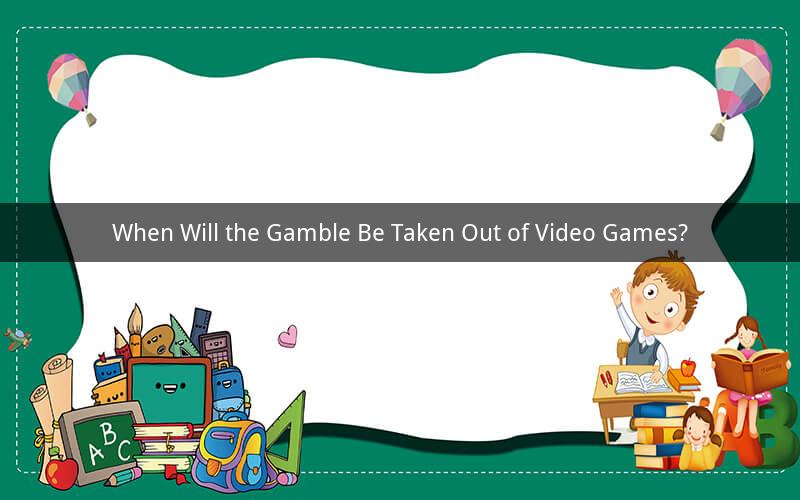
Table of Contents
1. The Evolution of Video Game Gambling
2. The Controversy Surrounding In-Game Gambling
3. The Impact on Young Players
4. Comparative Analysis: Traditional Gambling vs. In-Game Gambling
5. The Economic Perspective
6. Legal and Ethical Considerations
7. Case Studies: Success and Failures
8. The Role of Parental Guidance
9. The Technological Aspect
10. Public Opinion and Social Media Influence
11. The Future of Video Game Gambling
---
1. The Evolution of Video Game Gambling
The integration of gambling elements into video games has been a gradual evolution. From simple slot machines in early arcade games to sophisticated betting systems in modern online titles, the line between entertainment and gambling has blurred. The allure of virtual rewards and the thrill of competition have made in-game gambling a lucrative addition to the gaming industry.
2. The Controversy Surrounding In-Game Gambling
Critics argue that in-game gambling can lead to addictive behavior, especially among young players. They point to the psychological manipulation tactics used by developers to keep players engaged, such as the use of social proof, time constraints, and the promise of rare rewards. Proponents, however, argue that in-game gambling is a form of entertainment that can be controlled and that it provides a unique experience that traditional gambling cannot.
3. The Impact on Young Players
Young players are particularly vulnerable to the allure of in-game gambling. The ease of access, the use of virtual currency, and the integration of social elements can lead to excessive spending and gambling-related problems. Studies have shown a correlation between exposure to in-game gambling and increased risk-taking behavior in real life.
4. Comparative Analysis: Traditional Gambling vs. In-Game Gambling
While traditional gambling involves real money and often has legal and social consequences, in-game gambling operates within a virtual environment. The risk of financial loss is mitigated by the use of virtual currency, but the psychological impact can be similar. Additionally, the lack of regulation in the virtual world raises concerns about the potential for exploitation.
5. The Economic Perspective
From a financial standpoint, in-game gambling has proven to be a significant revenue stream for game developers. The ability to monetize the addiction to virtual rewards has opened up new opportunities for the gaming industry. However, the long-term sustainability of this model is questionable, given the potential for backlash and the ethical implications.
6. Legal and Ethical Considerations
The legal landscape surrounding in-game gambling is complex. While many countries have regulations in place for traditional gambling, the virtual nature of in-game gambling often falls into a legal gray area. Ethical concerns arise from the potential for exploitation, especially considering the target demographic of young players.
7. Case Studies: Success and Failures
Several high-profile cases have highlighted both the success and failures of in-game gambling. Companies like Zynga and King have successfully integrated gambling elements into their games, while others have faced backlash and regulatory scrutiny. These case studies provide valuable insights into the potential outcomes of in-game gambling.
8. The Role of Parental Guidance
Parental guidance is crucial in mitigating the risks associated with in-game gambling. Educating parents about the potential dangers and monitoring their children's gaming habits can help prevent problems. However, the onus cannot solely be on parents; developers and regulators must also take responsibility.
9. The Technological Aspect
Advancements in technology have made in-game gambling more immersive and realistic. From virtual reality to augmented reality, the gaming experience has evolved to provide a more engaging gambling environment. However, this also raises concerns about the potential for increased addiction and the blurring of the line between reality and virtual reality.
10. Public Opinion and Social Media Influence
Public opinion on in-game gambling is divided, with many expressing concerns about its impact on young players. Social media has played a significant role in shaping this discourse, with influencers and gamers voicing their opinions on platforms like Twitter, YouTube, and TikTok. The influence of these platforms cannot be underestimated.
11. The Future of Video Game Gambling
The future of in-game gambling is uncertain. As regulations continue to evolve and public opinion shifts, the gaming industry must navigate a complex landscape. Potential solutions include stricter regulations, better parental controls, and more transparent communication from developers. Only time will tell whether the gamble will be taken out of video games.
---
Questions and Answers
Q1: What are the main concerns regarding in-game gambling among young players?
A1: The main concerns include the potential for addiction, the psychological manipulation tactics used by developers, and the risk of excessive spending, which can lead to financial and psychological problems.
Q2: How does in-game gambling differ from traditional gambling in terms of legal and ethical considerations?
A2: In-game gambling operates within a virtual environment, often without the legal and social consequences associated with traditional gambling. However, the ethical concerns are similar, as both involve the potential for exploitation and addiction.
Q3: What role does parental guidance play in preventing problems related to in-game gambling?
A3: Parental guidance is crucial in educating children about the risks and monitoring their gaming habits. It is also important for parents to be aware of the features and mechanics of the games their children play.
Q4: How has technology influenced the development of in-game gambling?
A4: Technology has made in-game gambling more immersive and realistic, which can increase the risk of addiction. It has also provided new opportunities for developers to monetize their games through gambling elements.
Q5: What steps can be taken to ensure a safer gaming environment for young players?
A5: Steps include stricter regulations, better parental controls, transparent communication from developers, and ongoing education about the risks of in-game gambling. Collaboration between developers, regulators, and parents is essential in creating a safer gaming environment.